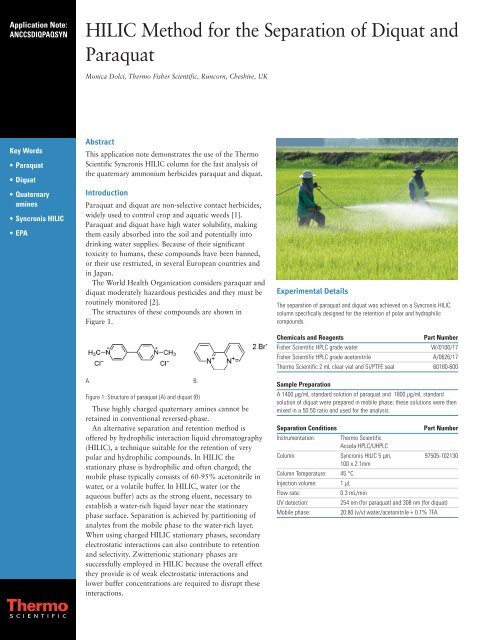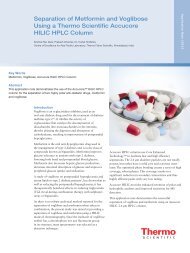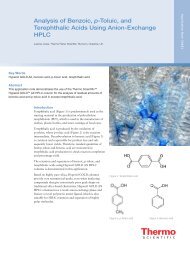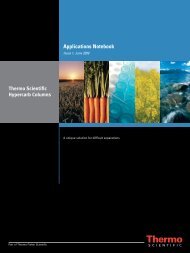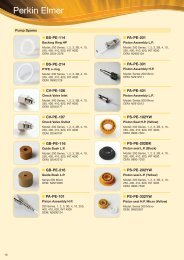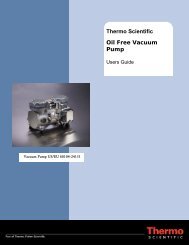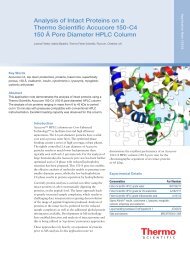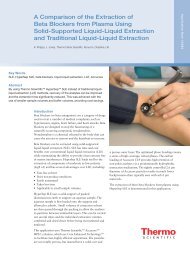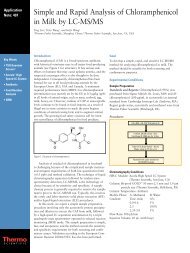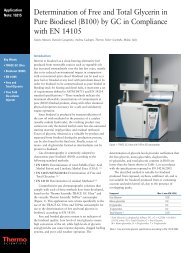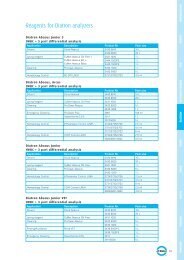HILIC Method for the Separation of Diquat and Paraquat
HILIC Method for the Separation of Diquat and Paraquat
HILIC Method for the Separation of Diquat and Paraquat
Create successful ePaper yourself
Turn your PDF publications into a flip-book with our unique Google optimized e-Paper software.
Application Note:<br />
ANCCSDIQPAQSYN<br />
<strong>HILIC</strong> <strong>Method</strong> <strong>for</strong> <strong>the</strong> <strong>Separation</strong> <strong>of</strong> <strong>Diquat</strong> <strong>and</strong><br />
<strong>Paraquat</strong><br />
Monica Dolci, Thermo Fisher Scientific, Runcorn, Cheshire, UK<br />
Key Words<br />
• <strong>Paraquat</strong><br />
• <strong>Diquat</strong><br />
• Quaternary<br />
amines<br />
• Syncronis <strong>HILIC</strong><br />
• EPA<br />
Abstract<br />
This application note demonstrates <strong>the</strong> use <strong>of</strong> <strong>the</strong> Thermo<br />
Scientific Syncronis <strong>HILIC</strong> column <strong>for</strong> <strong>the</strong> fast analysis <strong>of</strong><br />
<strong>the</strong> quaternary ammonium herbicides paraquat <strong>and</strong> diquat.<br />
Introduction<br />
<strong>Paraquat</strong> <strong>and</strong> diquat are non-selective contact herbicides,<br />
widely used to control crop <strong>and</strong> aquatic weeds [1].<br />
<strong>Paraquat</strong> <strong>and</strong> diquat have high water solubility, making<br />
<strong>the</strong>m easily absorbed into <strong>the</strong> soil <strong>and</strong> potentially into<br />
drinking water supplies. Because <strong>of</strong> <strong>the</strong>ir significant<br />
toxicity to humans, <strong>the</strong>se compounds have been banned,<br />
or <strong>the</strong>ir use restricted, in several European countries <strong>and</strong><br />
in Japan.<br />
The World Health Organization considers paraquat <strong>and</strong><br />
diquat moderately hazardous pesticides <strong>and</strong> <strong>the</strong>y must be<br />
routinely monitored [2].<br />
The structures <strong>of</strong> <strong>the</strong>se compounds are shown in<br />
Figure 1.<br />
A. B.<br />
Figure 1: Structure <strong>of</strong> paraquat (A) <strong>and</strong> diquat (B)<br />
These highly charged quaternary amines cannot be<br />
retained in conventional reversed-phase.<br />
An alternative separation <strong>and</strong> retention method is<br />
<strong>of</strong>fered by hydrophilic interaction liquid chromatography<br />
(<strong>HILIC</strong>), a technique suitable <strong>for</strong> <strong>the</strong> retention <strong>of</strong> very<br />
polar <strong>and</strong> hydrophilic compounds. In <strong>HILIC</strong> <strong>the</strong><br />
stationary phase is hydrophilic <strong>and</strong> <strong>of</strong>ten charged; <strong>the</strong><br />
mobile phase typically consists <strong>of</strong> 60-95% acetonitrile in<br />
water, or a volatile buffer. In <strong>HILIC</strong>, water (or <strong>the</strong><br />
aqueous buffer) acts as <strong>the</strong> strong eluent, necessary to<br />
establish a water-rich liquid layer near <strong>the</strong> stationary<br />
phase surface. <strong>Separation</strong> is achieved by partitioning <strong>of</strong><br />
analytes from <strong>the</strong> mobile phase to <strong>the</strong> water-rich layer.<br />
When using charged <strong>HILIC</strong> stationary phases, secondary<br />
electrostatic interactions can also contribute to retention<br />
<strong>and</strong> selectivity. Zwitterionic stationary phases are<br />
successfully employed in <strong>HILIC</strong> because <strong>the</strong> overall effect<br />
<strong>the</strong>y provide is <strong>of</strong> weak electrostatic interactions <strong>and</strong><br />
lower buffer concentrations are required to disrupt <strong>the</strong>se<br />
interactions.<br />
Experimental Details<br />
The separation <strong>of</strong> paraquat <strong>and</strong> diquat was achieved on a Syncronis <strong>HILIC</strong><br />
column specifically designed <strong>for</strong> <strong>the</strong> retention <strong>of</strong> polar <strong>and</strong> hydrophilic<br />
compounds.<br />
Chemicals <strong>and</strong> Reagents<br />
Part Number<br />
Fisher Scientific HPLC grade water<br />
W/0106/17<br />
Fisher Scientific HPLC grade acetonitrile<br />
A/0626/17<br />
Thermo Scientific 2 mL clear vial <strong>and</strong> Si/PTFE seal 60180-600<br />
Sample Preparation<br />
A 1400 µg/mL st<strong>and</strong>ard solution <strong>of</strong> paraquat <strong>and</strong> 1800 µg/mL st<strong>and</strong>ard<br />
solution <strong>of</strong> diquat were prepared in mobile phase; <strong>the</strong>se solutions were <strong>the</strong>n<br />
mixed in a 50:50 ratio <strong>and</strong> used <strong>for</strong> <strong>the</strong> analysis.<br />
<strong>Separation</strong> Conditions<br />
Instrumentation:<br />
Thermo Scientific<br />
Accela HPLC/UHPLC<br />
Part Number<br />
Column: Syncronis <strong>HILIC</strong> 5 µm, 97505-102130<br />
100 x 2.1mm<br />
Column Temperature: 45 °C<br />
Injection volume: 1 µL<br />
Flow rate:<br />
0.3 mL/min<br />
UV detection:<br />
254 nm (<strong>for</strong> paraquat) <strong>and</strong> 308 nm (<strong>for</strong> diquat)<br />
Mobile phase:<br />
20:80 (v/v) water/acetonitrile + 0.1% TFA
Syncronis <strong>HILIC</strong> columns are based on highly pure<br />
100 Å silica, with a surface area <strong>of</strong> 320 m 2 /g. The<br />
zwitterionic modified stationary phase results in total<br />
charge equalisation <strong>and</strong> <strong>the</strong>re<strong>for</strong>e a neutral but highly<br />
polar surface, which <strong>of</strong>fers enhanced retention <strong>of</strong> polar<br />
<strong>and</strong> hydrophilic analytes.<br />
This application note shows an efficient <strong>and</strong><br />
reproducible <strong>HILIC</strong> method <strong>for</strong> <strong>the</strong> analysis <strong>of</strong> paraquat<br />
<strong>and</strong> diquat, with excellent peak shape <strong>and</strong> baseline<br />
resolution.<br />
Results<br />
The herbicides paraquat <strong>and</strong> diquat were retained <strong>and</strong><br />
separated on <strong>the</strong> Syncronis <strong>HILIC</strong> column, using an<br />
isocratic method with 0.1% TFA added to <strong>the</strong> mobile<br />
phase. Figure 2 shows <strong>the</strong> chromatogram obtained<br />
employing Syncronis <strong>HILIC</strong> 5 µm, 100 x 2.1 mm column,<br />
with paraquat eluting at 1.30 min <strong>and</strong> diquat eluting at<br />
1.47 min.<br />
The following chromatographic parameters were<br />
monitored: retention time t R , peak area, <strong>and</strong> resolution<br />
Rs. Mean <strong>and</strong> % RSD values <strong>for</strong> <strong>the</strong> above parameters<br />
were based on data derived from six replicate injections,<br />
<strong>and</strong> <strong>the</strong>y are reported in Table 1.<br />
mAU<br />
3000<br />
2000<br />
1000<br />
<strong>Paraquat</strong> (254 nm)<br />
<strong>Diquat</strong> (308 nm)<br />
Conclusions<br />
The use <strong>of</strong> a Syncronis <strong>HILIC</strong> column allowed <strong>the</strong><br />
successful retention <strong>and</strong> separation <strong>of</strong> <strong>the</strong> quaternary<br />
ammonium compounds paraquat <strong>and</strong> diquat. Syncronis<br />
<strong>HILIC</strong> columns are an excellent choice <strong>for</strong> <strong>the</strong> <strong>HILIC</strong><br />
separation <strong>of</strong> paraquat <strong>and</strong> diquat, af<strong>for</strong>ding highly<br />
reproducible analysis<br />
References<br />
[1] Determination <strong>of</strong> diquat <strong>and</strong> paraquat in drinking<br />
water by Liquid-Solid Extraction <strong>and</strong> High Per<strong>for</strong>mance<br />
Liquid Chromatography with Ultraviolet Detection; U.S.<br />
EPA <strong>Method</strong> 549.2, Revision 1.0, Environmental<br />
Protection Agency: Cincinnati, OH, 1997.<br />
[2] http://www.who.int/whosis/en/ World Health<br />
Organization.<br />
<strong>Paraquat</strong> t R (min) Peak Area<br />
Mean 1.30 7361563<br />
SD 0.01 98638.00<br />
% RSD 0.43 1.34<br />
<strong>Diquat</strong> t R (min) Peak Area Rs<br />
Mean 1.47 7414798 1.61<br />
SD 0.01 104719.97 0.01<br />
% RSD 0.50 1.41 0.66<br />
Table 1: Average <strong>and</strong> <strong>Method</strong> Precision (%RSD) <strong>of</strong> chromatographic<br />
parameters, derived from <strong>the</strong> analysis <strong>of</strong> paraquat <strong>and</strong> diquat on a Syncronis<br />
<strong>HILIC</strong> 5 µm, 100 x 2.1 mm column (data calculated from six replicate<br />
injections)<br />
In addition to <strong>the</strong>se<br />
<strong>of</strong>fices, Thermo Fisher<br />
Scientific maintains<br />
a network <strong>of</strong> represen -<br />
tative organizations<br />
throughout <strong>the</strong> world.<br />
North America<br />
USA <strong>and</strong> Canada<br />
+1 800 332 3331<br />
Europe<br />
France<br />
+33 (0)1 60 92 48 34<br />
Germany<br />
+49 (0) 2423 9431 -20<br />
or -21<br />
United Kingdom<br />
+44 1928 534110<br />
Asia<br />
Japan<br />
+81 3 5826 1615<br />
China<br />
+86-21-68654588<br />
or +86-10-84193588<br />
800-810-5118<br />
India<br />
+91-22-6742 9494<br />
Thermo Fisher<br />
Scientific Australia<br />
Pty Ltd<br />
1300 735 292 (free call<br />
domestic)<br />
Thermo Fisher<br />
Scientific New<br />
Zeal<strong>and</strong> Ltd<br />
0800 933 966 (free call<br />
domestic)<br />
All O<strong>the</strong>r Enquiries<br />
+44 (0) 1928 534 050<br />
0<br />
0 0.5 1.0 1.5 2.0 2.5 3.0 3.5 4.0 4.5 5.0<br />
Time (Minutes)<br />
Figure 2: Chromatogram <strong>of</strong> paraquat <strong>and</strong> diquat, separated on a Syncronis<br />
<strong>HILIC</strong> 5 µm, 100 x 2.1 mm column<br />
Technical<br />
Support<br />
North America<br />
800 332 3331<br />
Outside North<br />
America<br />
+44 (0) 1928 534 440<br />
www.<strong>the</strong>rmoscientific.com/chromatography<br />
© 2012 Thermo Fisher Scientific Inc. All rights reserved. All trademarks are <strong>the</strong> property <strong>of</strong> Thermo Fisher Scientific Inc. <strong>and</strong> its subsidiaries.<br />
Specifications, terms <strong>and</strong> pricing are subject to change. Not all products are available in all countries. Please consult your local sales representative <strong>for</strong> details.<br />
ANCCSDIQPAQSYN 0112<br />
Part <strong>of</strong> Thermo Fisher Scientific


